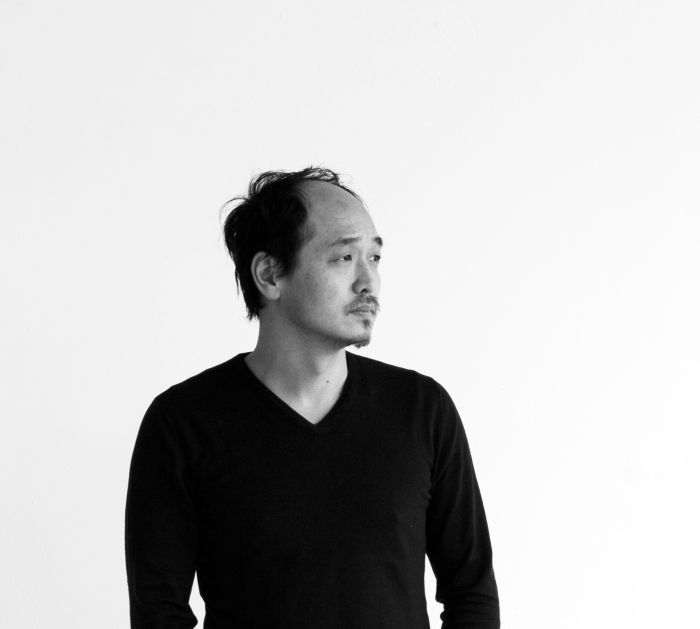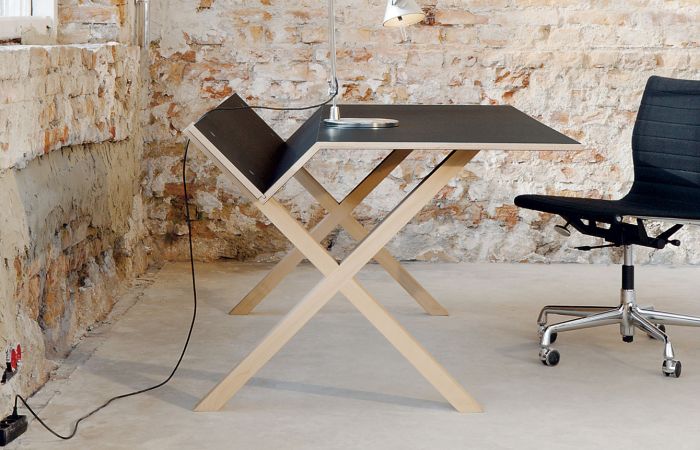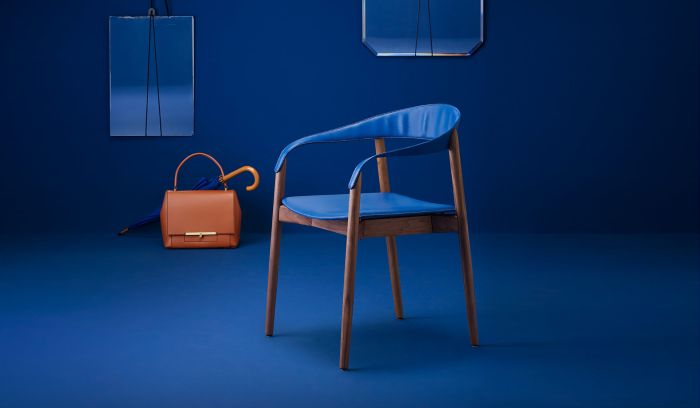#campustour Interview: Patrick Frey, Assistant Professor, Hochschule Hannover
Just as the Eamsien adage proclaims that “the details are not the details; they make the product”, so too are a design school’s teaching staff not the teaching staff, they make the school.
Consequently, it follows that to better understand not only an individual institution, but also both the wider contemporary condition, and possible future directions, of design education, it is important to talk to, and understand, design school teaching staff; both those full-time Professors, and also those practising designers who have accepted the responsibility of instructing future generations.
Practising designers such as Patrick Frey, Assistant Professor at the Hochschule Hannover.
A graduate himself of the Hochschule Hannover, Patrick Frey first made a name for himself with the desks Kant and Marketing, developed, together with Markus Boge, in context of their joint diploma project, and which, in addition to success in international competitions, entered production with German manufacturer Nils Holger Moormann. Following several years as a joint studio, Patrick and Marcus went their separate ways in 2007, since when Patrick Frey has realised projects for manufacturers as varied as, and amongst many others, Villeroy & Boch, Richard Lampert, Freifrau or Bree.
In 2010 Patrick Frey took up a teaching post at the Hochschule für angewandte Wissenschaft und Kunst, HAWK, Hildesheim, before returning in 2014 to his alma mater with a Product Design Professorship in Hannover. In context of our #campustour we met up with Patrick to discuss the product design course in Hannover, the contrast to his time as a student and contemporary design education, but began, as ever, by asking what led him to follow a career in design?
Patrick Frey: That started very early, by age nine I knew that I wanted to be a designer. Growing up creativity was always present, my mother is a ceramicist, my father considered architecture, went into teaching, and from an early age I knew what designers did, that they create all those objects which surround us, which fascinated me and was something I also wanted to do. Immediately after completing my Zivildienst I started an internship here in Hannover at the industrial design office Lindinger und Partner, asked Herbert Lindinger where he thought I should study, he said Hannover’s super, and so I stayed here.
smow Blog: And you’re still here, your first teaching position however was at HAWK Hildesheim, why the decision to enter into teaching, and why Hildesheim?
Patrick Frey: Very simply Professor Andreas Schulz asked me if I’d be interested in a position in Hildesheim! That I said yes was on the one hand because I’d never worked with students, and that was something which interested me, not least because I’d had several interns and realised that they were not only interested in what I was telling them, but were taking that and developing it further in their own way, and for me that was a motivation to then do the same in a college environment. And secondly, at Hildesheim I wasn’t limited to just industrial design but had the freedom to teach more experimental product design, which is very much my thing and that ultimately made it an interesting and rewarding experience.
smow Blog: Which raises the question of why then the switch to Hannover?
Patrick Frey: Gunnar Spellmeyer, with whom I had worked as a student at the agency Formfuersorge, was appointed a Professor at Hannover and asked me if I’d be interested in helping develop the programme here. And saying yes was fairly simple, not just because it involved less travelling, but for all because the connection to and contact with the students is important to me, that the students know I’m available for them, am interested in them, and here in Hannover there is always, for example, the option for a spontaneous meeting when there is a need for a discussion.
smow Blog: In terms of the course here in Hannover, is it a pure project based course or……..?
Patrick Frey: Projects but also theory. The first two semesters are mixed, all who are in any way involved with design study together and then starts the specialisation. It’s a very structured course of studies, which it has to be because with the Bachelor everything has gotten very tight, you have to achieve a lot in a relatively short time, certainly in comparison to when I was a student. I studied twelve semesters, with several holiday semesters along the way, and for me it wasn’t so important to finish studying, but rather to study so long until I felt I was finished, today one has the feeling that the students want to be finished as quickly as possible, which probably comes from the more structured nature of the Bachelor.
smow Blog: And do today’s students also, possibly, have a different understanding of the design profession as was the case when you started?
Patrick Frey: I wouldn’t say so. Personally for me it was a calling, and one still finds such today, and such students are what we are looking for, those for whom design is a calling, but in general I’d say the varying perceptions about the design profession that we see today are as they were then. Whereby one also has to understand that students often don’t know at the beginning where they want to go, and so for us as a Hochschule we want to offer a broad palette where they can try out a variety of directions, and then during their studies develop a more concrete position of their own.
smow Blog: Also away from say traditional industrial or product design…..
Patrick Frey: Absolutely, an important change since I studied here is that today the students projects don’t necessarily automatically lead to a physical product, rather there are also purely conceptual projects, and for me that is a very important development as there are individuals who have a very close relationship to design, but who aren’t necessarily interested in creating products and such people are good to have in a course because they bring alternative perspectives and ideas.
smow Blog: And does the strict time table allow space for internships, and for you is a internship a sensible step?
Patrick Frey: The fifth semester is for internships and for me that is very important because otherwise the students don’t have this practical relevance, this understanding of what actually happens in a company or a design bureau. Sometimes they are enthralled, sometimes shocked, sometimes disillusioned and occasionally they know then what they don’t want, and every experience is equally valuable, and it is very much the case that that experience is often influential in their future careers.
smow Blog: Meaning that they also end up doing their Bachelor project with a internship partner, or even working with them……..?
Patrick Frey: Yes, does happen, we have, for example, a lot of partners with whom we organise semester projects, and through those projects students get to know the partners and when they like what they do and how they do it then often they complete their Internship there. And we have the wonderful situation here that many of the students are then later taken on by the partner, which is a very positive situation, even if having a job offer does make the decision whether or not to do a master more difficult. Whereby I’d always argue to do a master!
smow Blog: And in terms of freelancing, given your own experience would you advise students to establish their own studio?
Patrick Frey: It would be negligent when I would advise against, but I would also never try to actively encourage someone. All I can do is explain what I see as the advantages and disadvantages, talk about my experiences, whereby I always try to be very realistic about the reality as a freelance designer. But I would also advise them to ask other freelancers, who maybe have different experiences and a different perspective.
smow Blog: When you say explain the reality as a freelance designer, does that also include your experiences with manufacturers, keyword business aspects….?
Patrick Frey: Very much so, that is something I am very particular about, especially explaining the importance of negotiating some form of development payments before starting to develop a project.
smow Blog: Do you always ask for development payments?
Patrick Frey: Sofort. Immediately. Otherwise I don’t even start a project. On the one hand I can’t afford it, I have a family, responsibilities, and on the other I want such development payments to become standard, and I must practice what I preach and not contribute to a system I consider needs reforming.
smow Blog: And more generally what do you aim to impart on your students?
Patrick Frey: My own position towards design is that which I can best represent, and so where most discussions tend to start, for example that for me design is not just about superficial forming rather something which has a concept behind it, that it concerns the social culture context and that for all that my design won’t change the world. That is a stupid, naive, illusion, rather as designers we can do no more than present food for thought, propose alternative possibilities.
smow Blog: Whereby there is no doubt one or the other student who enters the course thinking they can change the world?
Patrick Frey: Which is fine, why not? To be honest I’d probably be more concerned if someone didn’t want to! But no, let them think that and then let’s see where the journey takes them. What often motivates young students is a desire to change society’s consumer behaviour, as designers we provide the fuel for global consumption and for a lot of students a motivation is how they can, positively, influence such. But that’s a huge field and you can’t just start in that you open Pandora’s Box and say I want change everything, rather you must consider where can I make adaptions, where can I introduce a little more sustainability or understanding, and the students realise that quite quickly.
smow Blog: Changing tact slightly, Hochschule Hannover exhibit in Milan, is that worth it, or does one get lost in the general mass……..?
Patrick Frey: No, no, Milan is good because on the one hand lots of people come, you can present yourself to a large, varied, international public, and then one has an opportunity to meet international design schools, to discuss what they are doing, where particular ideas are moving, and through such contact longer term relationships can develop, for example a delegation from Hannover are going to Mexico City in October, to the UNAM university, and this internationalisation is something we try to develop, to encourage the students to expand their horizons, in my opinion every student should spend some time overseas. Milan is also good in that one meets lots of potential masters students, a lot of students use Milan to help them decide where to do a masters, and so it is a good platform to allow us to explain what we can offer.
smow Blog: And to end, if you had one piece of advice for new graduates…….?
Patrick Frey: Don’t sell yourself under your worth, and be aware that you can do something. Many students are often unclear as to what they can do, with a plumber or a carpenter it is obvious, as a designer it is more complicated, yet can still be formulated. But perhaps most importantly, having developed a position towards design during your studies, guard it closely and don’t do what you don’t want to!
Full details on Patrick Frey and his work can be found at www.patrick-frey.com
Full details on product design courses at the Hochschule Hannover can be found at http://produktdesign-studium.de/
Tagged with: #campustour, Hannover, Hochschule Hannover, Kant, Moormann, Patrick Frey




